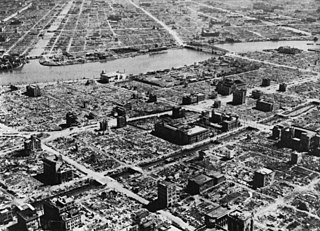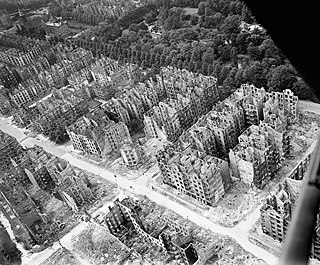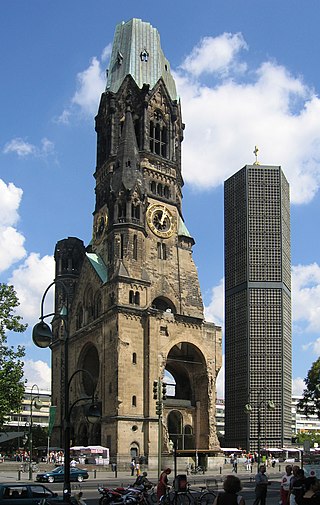
Strategic bombing is a systematically organized and executed attack from the air which can utilize strategic bombers, long- or medium-range missiles, or nuclear-armed fighter-bomber aircraft to attack targets deemed vital to the enemy's war-making capability. It is a military strategy used in total war with the goal of defeating the enemy by destroying its morale, its economic ability to produce and transport materiel to the theatres of military operations, or both. The term terror bombing is used to describe the strategic bombing of civilian targets without military value, in the hope of damaging an enemy's morale.

The Battle of Britain was a military campaign of the Second World War, in which the Royal Air Force (RAF) and the Fleet Air Arm (FAA) of the Royal Navy defended the United Kingdom (UK) against large-scale attacks by Nazi Germany's air force, the Luftwaffe. It was the first major military campaign fought entirely by air forces. The British officially recognise the battle's duration as being from 10 July until 31 October 1940, which overlaps the period of large-scale night attacks known as the Blitz, that lasted from 7 September 1940 to 11 May 1941. German historians do not follow this subdivision and regard the battle as a single campaign lasting from July 1940 to May 1941, including the Blitz.

The Blitz was a German bombing campaign against the United Kingdom, in 1940 and 1941, during the Second World War. The term was first used by the British press and originated from the term Blitzkrieg, the German word meaning 'lightning war'.

Firebombing is a bombing technique designed to damage a target, generally an urban area, through the use of fire, caused by incendiary devices, rather than from the blast effect of large bombs. In popular usage, any act in which an incendiary device is used to initiate a fire is often described as a "firebombing".
The Baedeker Blitz or Baedeker raids was a series of aerial attacks in April and May 1942 by the German Luftwaffe on English cities during the Second World War. The name derives from Baedeker, a series of German tourist guide books, including detailed maps, which were used to select targets for bombing.

Montbéliard is a town in the Doubs department in the Bourgogne-Franche-Comté region in eastern France, about 13 km (8 mi) from the border with Switzerland. It is one of the two subprefectures of the department.

The Allied bombing of Hamburg during World War II included numerous attacks on civilians and civic infrastructure. As a large city and industrial centre, Hamburg's shipyards, U-boat pens, and the Hamburg-Harburg area oil refineries were attacked throughout the war.

World War II (1939–1945) involved sustained strategic bombing of railways, harbours, cities, workers' and civilian housing, and industrial districts in enemy territory. Strategic bombing as a military strategy is distinct both from close air support of ground forces and from tactical air power. During World War II, many military strategists of air power believed that air forces could win major victories by attacking industrial and political infrastructure, rather than purely military targets. Strategic bombing often involved bombing areas inhabited by civilians, and some campaigns were deliberately designed to target civilian populations in order to terrorize them and disrupt their usual activities. International law at the outset of World War II did not specifically forbid the aerial bombardment of cities – despite the prior occurrence of such bombing during World War I (1914–1918), the Spanish Civil War (1936–1939), and the Second Sino-Japanese War (1937–1945).
The Pathfinders were target-marking squadrons in RAF Bomber Command during World War II. They located and marked targets with flares, at which a main bomber force could aim, increasing the accuracy of their bombing. The Pathfinders were normally the first to receive new blind-bombing aids such as Gee, Oboe and the H2S radar.

The Birmingham Blitz was the heavy bombing by the Nazi German Luftwaffe of the city of Birmingham and surrounding towns in central England, beginning on 9 August 1940 as a fraction of the greater Blitz, which was part of the Battle of Britain; and ending on 23 April 1943. Situated in the Midlands, Birmingham, the most populous British city outside London, was considered an important industrial and manufacturing location. Around 1,852 tons of bombs were dropped on Birmingham, making it the third most heavily bombed city in the United Kingdom in the Second World War, behind London and Liverpool.

The bombing of Augsburg in World War II included two British RAF and one USAAF bombing raids against the German city of Augsburg on 17 April 1942 and 25/26 February 1944.

During World War II, Braunschweig was attacked by Allied aircraft in 42 bombing raids. On the night of 14/15 October 1944, the attack by No. 5 Group Royal Air Force (RAF) marked the high point of the destruction of Henry the Lion's city during the war. The air raid was part of Operation Hurricane, which was designed to demonstrate the capabilities of the Allied bombing campaign. The attack caused a massive conflagration, that might have developed into a firestorm, and resulted in Braunschweig burning continuously for two and a half days from 15 to 17 October. More than 90 percent of the medieval city centre was destroyed, changing the city's appearance to the present day.

The Battle of Berlin was a bombing campaign against Berlin by RAF Bomber Command along with raids on other German cities to keep German defences dispersed. Air Chief Marshal Sir Arthur Harris, Air Officer Commanding-in-Chief (AOC-in-C) Bomber Command, believed that "We can wreck Berlin from end to end if the USAAF come in with us. It will cost us between 400 and 500 aircraft. It will cost Germany the war".
The German city of Mannheim in the state of Baden-Württemberg saw bombing during World War II from December 1940 until the end of the war. Mannheim saw over 150 air raids.

Adlertag was the first day of Unternehmen Adlerangriff, an air operation by Nazi Germany's Luftwaffe intended to destroy the British Royal Air Force (RAF). The operation came during the Battle of Britain after Britain rejected all overtures for a negotiated peace with Germany. However, Adlertag and subsequent operations failed to destroy the RAF or gain local air superiority.

During World War II, Leipzig was repeatedly attacked by British as well as American air raids. The most severe attack was launched by the Royal Air Force in the early hours of 4 December 1943 and claimed more than 1,800 lives. Large parts of the city center were destroyed, while factories experienced temporary shortfalls in production, had to move production facilities or even were decentralized.
Bregille is a district of the French city of Besançon, located on the right bank of the Doubs, south-east of the historic center. It has developed on the eponymous hill Bregille which culminates at 458 meters, almost 200 meters above the river level. It has about 6 500 inhabitants in the early 2000s.

As the main economic and industrial center in Italy, and the country's second largest city, Milan was subjected to heavy bombing during World War II, being the most bombed city in Northern Italy and one of the most bombed cities in the country.

During World War II, Tuscany, the Italian port city of Livorno was repeatedly bombed by the Allied air forces, suffering about a hundred raids altogether, which resulted in it being among the most war-damaged cities in Italy.


















